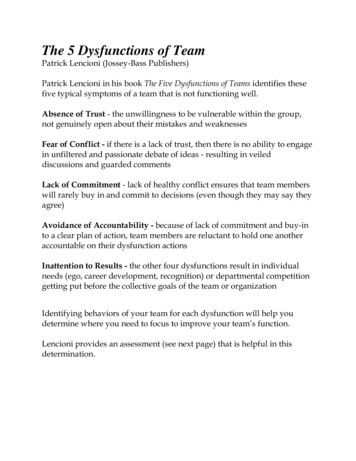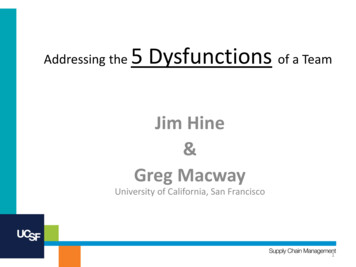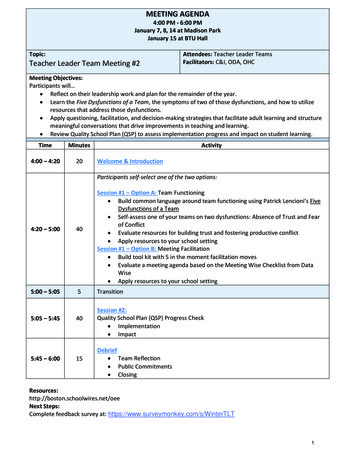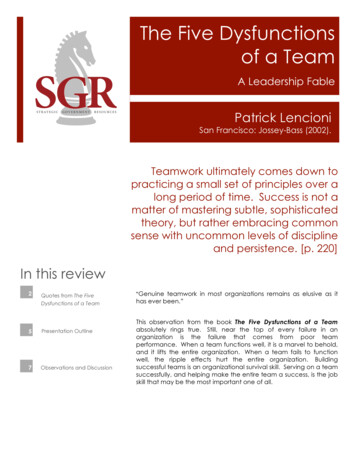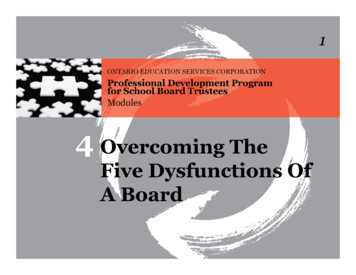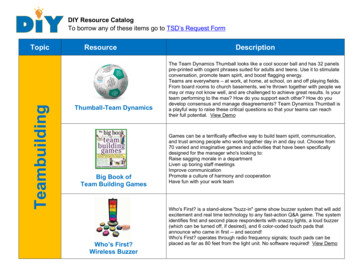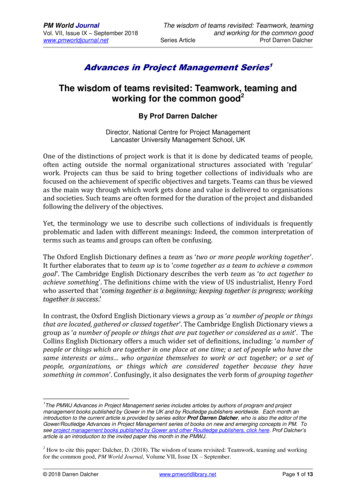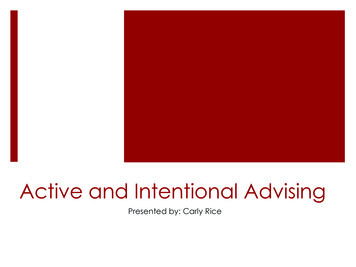
Transcription
The Five Dysfunctionsof a TeamPatrick Lencioni
Welcome to EquiptWelcome to Equipt, a book summary platformthat offers summaries of the most relevantbooks in leadership, Christian formation, andspiritual growth throughthe lens of ChristiantDiscipleship. Our hope is that by using Equipt,the faithful can grow and go to the ends of theearth Equipt to face the rising challenges ofapostolic work in our ever-changing world.
IN SHORTfififiKathryn Petersen is appointed chief executiveof cer of a young technology company. Insteadof focusing on increasing sales or improvingproducts, she focuses her attention onimproving teamwork at the executive level. Thisfocus on teamwork leads the executives to makebetter decisions and improve the success of thecompany. She identi es ve dysfunctional habitsof her team and uses practical exercises toovercome them.
First Dysfunction:Lack of Trust“Trust lies at the heart of a functioning,cohesive team. Without it, teamwork is allbut impossible (195).”Trust is needed but often misunderstood. It does not mean “I trustyou’ll get a task done” or “I trust you will keep this secret.” That’smerely a prediction based on past behavior. The kind of trustneeded on a team is, “I trust that your intentions are good.” Whenthat kind of trust is there, team members feel safe and can be open.For example, at Our Lady of Sorrows Parish, there is a director ofreligious education (DRE) named Sandra who has worked at theparish for 25 years. She is incredibly suspicious of her fellowemployees because she believes they slack off, and everyone isaware of this. A new hire, Ricardo, is brought onto the faithformation team and asks for help planning an event. Sandra makes acomment about how when she planned that event last year, she wasable to put it together herself. Do you think Ricardo will be quick toask for help again?Sandra lacked trust in her team from the start, and that lack of trustcaused her to act in a way that decreased Ricardo’s ability to trust.The need to feel safe in a given space is a basic human need, rightabove the need for food on Maslow’s hierarchy of needs. Whenteam members feel guarded, they expend time and energy onpolitics and other false methods of security.To create trust with your team, take time to talk about personalhistories, like “number of siblings, hometown, unique challenges of
childhood, etc. (198-199).” You can also utilize personality pro lingtools like Myers-Briggs or DiSC assessments.The team leader is the most responsible for taking this rst step invulnerability. Be willing to admit mistakes and avoid coming downhard on people for their mistakes. If a team member admits amistake, don’t punish that admission by immediately chastisingthem for the mistake.Second Dysfunction:Avoidance of ConflictOnce trust is established, the second dysfunction is easier toovercome. When team members trust that everyone is acting withgood intentions, they are less inclined to hold back their thoughtsand opinions. Often, two people’s thoughts and opinions willcon ict with one another.The goal of conflict is “to produce the bestpossible solution in the shortest period of time(202-203). ”It ensures most if not all ideas are put on the table forconsideration. Unfortunately, con ict can feel uncomfortable so wetend to avoid it.fififlflflflThe alternatives to open con ict are not great. No team is trulycon ict-free. The appearance of harmony through silence does nottruly serve the team. If people don’t disagree openly, they willdisagree in private either in their heads or in parking lotconversations. These things only serve to break down team unity inthe long run.
To avoid these things, leaders should encourage open con ict inteam meetings. You do this by “mining” for con ict, meaning lookfor people who may not be voicing a contrary opinion, and coax itout of them. Give people real-time permission to speak out.Verbalizing con ict will foster a good conversation and reinforcethat idea for the rest of the team.(For more on con ict, look for our summary of Death by Meeting.)Third Dysfunction:Lack of CommitmentCon ict leads to commitment. When every team member has voicedhis or her concerns and it comes me to make a decision, it’s easier foreveryone to commit, even if they ini ally disagreed. “Reasonablehuman beings do not need to get their way in order to support adecision (p.207).”Commitment comes from a combination ofclarity and buy-in. The enemies ofcommitment are the desires forconsensus and certainty.A er con ict has resulted in a decision, make sure everyone is clear onwhat their role is going forward and is taking ownership of their role.This is especially important at the top leadership level, because lack ofclarity at the top means even more at the bo om.flfifltttitititiflflftflftflflftConsensus is a poor subs tute for buy-in and certainty is an obstacle toclarity. Consensus uses compromise to achieve buy-in instead ofcon ict, and is o en used on teams with stubborn members. Certaintycan get in the way of achieving clarity since it is an impossible goal.Leaders o en avoid picking a clear direc on because they rst want to
be certain about that direc on. It is much be er to be wrong andchange course than to switch between several decisions.The most effective tool for clarity is called “cascading messaging.”At the end of each staff meeting, the team reviews decisions made,who is doing what, what needs to be communicated, and how tofollow-up. This type of clarity ensures things do not get missed, assometimes people assume something is clear when it is not.Fourth Dysfunction:Lack of AccountabilityTactics like cascading messaging lead directly into the fourthdysfunction. You cannot create accountability without rstachieving clarity and commitment from your team members. It isirrational to hold someone accountable for something unclear orsomething they didn’t commit to.On the ip side of this, when clarity and commitment exist butpeople are not held accountable, productivity breaks down. Anatural human thought sets in: if they don’t have to work hard, whyshould I? This is why accountability is a team effort.When clarity and commitment happen in front of the whole team,the whole team is invested in getting its objectives done. Ideally,this will lead to team members holding each other accountable.Sometimes, team members won’t hold each other accountablebecause they assume the leader is doing it.fitttiflIt is ultimately the leader’s job to hold their direct reportsaccountable, but this should be the last resort.
Fifth Dysfunction:Inattention to ResultsThe nal dysfunction is the inattention to results. The converse ofwhich is the attention of results, but the question is: which results?Many individual team members are focused on their ownadvancement or personal agendas than the goals of the team itself.The goals of the team should be clearly communicated and openlycommitted to by each team member. Still, some have the tendencyto look out for their own interest.Your team has a scorecard and thatscorecard is the short-term and long-termgoals of your organization. If someone isusing their own scorecard, that’s dangerous.This looks different depending on your organization. Sometimestheir scorecard is personal gain, like a team member who pushesagainst the new building because she likes her old of ce.Sometimes it is about status, like a team member who is satis edwith simply reporting to the pastor and is not concerned withachieving any goals.The way to get rid of alternate scorecards is to only rewardachievements for the team’s scorecard. A simple way to do this is topublicly state what results you are expecting. That way, there ispressure on the whole team to meet those goals. Another way isresults-based rewards. Base rewards on outcomes, so people willwork harder for those outcomes.fififiIn the Church, it can feel taboo to tie money to results, especiallyfor those employed in the ministry side of things. This concernmakes sense because we don’t want people to be in ministry for the
money. However, it is likely that your parish staff is not in it for themoney.Let’s say your staff goal is to increase the number of attendees at anAlpha event and your DRE spends her weekend talking to peopleoutside Wal-Mart. If you hit your goal, don’t be afraid to give her abonus. It’s not simony, it’s an indication that you value what she didand will encourage that behavior in the future.fiflAs disciples there are countless ways that we nd ourselves coworkers in the vineyard for building God’s Kingdom. Working withothers in a way that fosters unity, teamwork, and trust better helpsus re ect the order that God intends among His children.
EQUIPT TAKEAWAYSBuild TrustTo trust a team member means to know they have goodintentions.Foster Healthy ConflictCon ict will produce the best solution in the shortestamount of time.Clarify & CommitCommitment comes from clarity and buy-in,not consensus and certainty.Win TogetherAccountability is a team sport.Celebrate SuccessflReward the right results openly and often.
NEXT STEPSBuy The Five Dysfunctions of a Team on AmazonCheck out Patrick Lencioni’s Amazing Parish(look for our summary of Death By Meeting for an indepth look at how to better use con ict in your meetings.)Lencioni, Patrick. The Five Dysfunctions of a Team:A Leadership Fable. San Francisco, CA: Jossey-Bass, 2002.flAnd we do have God. He is here with you, right now—he haspromised that he is with us always. It’s a lot easier to focus onhim, to be free, after entrusting your
Buy The Five Dysfunctions of a Team on Amazon Check out Patrick Lencioni's Amazing Parish (look for our summary of Death By Meeting for an in-depth look at how to better use conflict in your meetings.) Lencioni, Patrick. The Five Dysfunctions of a Team: A Leadership Fable. San Francisco, CA: Jossey-Bass, 2002.


